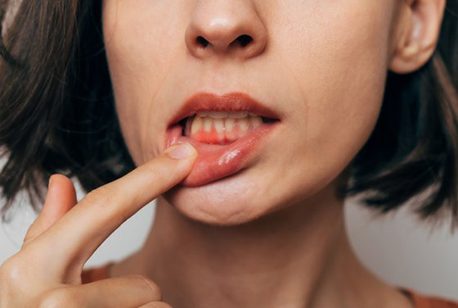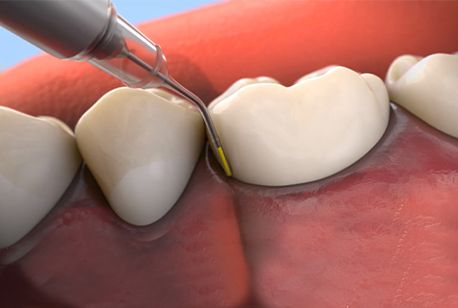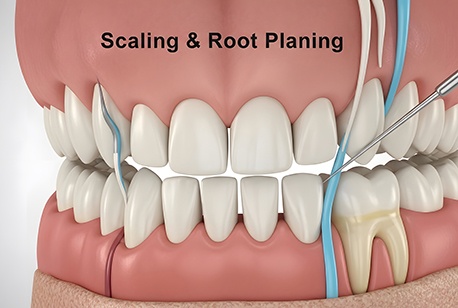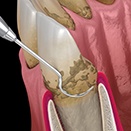Periodontal Therapy – Loveland, OH
Protect Your Gums from Infection
Dr. Gerome and Dr. Patrice are extremely concerned about gum disease because it is the main cause of tooth loss among American adults and is an unfortunately common problem. Gum disease is also linked to heart attack, stroke, and diabetes. At every checkup, we’ll look for signs of gum infections and make recommendations for appropriate periodontal therapy in Loveland to prevent long-term damage to your gums and teeth.

Why Choose Gerome & Patrice Family Dentistry for Periodontal Therapy?
- Arestin Antibiotic Therapy Available for Faster Healing
- Soft Tissue Laser Ensures More Comfortable Treatment
- Friendly Team and Dentists Dedicated to Personalized Care
What is Gum Disease?

Almost half of adults thirty years and older have some form of gum disease, and the risk increases with age. This oral health problem starts as inflammation called gingivitis, and it can usually be reversed at this stage with improved oral hygiene. However, it will eventually progress to periodontitis if left untreated, which results in permanent damage that must be managed with regular professional dental treatments. Gum disease is caused by a bacterial infection affecting the gums and bone structures supporting the teeth, and it is more common in men than women and those living below the federal poverty level. Other risk factors include smoking, certain genetic conditions, pregnancy, and health issues like diabetes.
Symptoms of Gum Disease

Gingivitis, the first stage of gum disease, may show itself through symptoms like:
- Bad breath
- Swollen gums
- Dark or angry red gums
- Bleeding during brushing or flossing sessions.
- Tenderness
- Gum recession
Periodontitis typically involves symptoms like:
- Painful chewing
- Permanent teeth coming loose
- Dental sensitivity
- Altered bite alignment
- Dental restorations fitting differently
- Permanent tooth loss
How Do We Treat Gum Disease?

The team at Gerome & Patrice Family Dentistry will thoroughly inspect your mouth to determine the severity of your infection and determine the best possible treatment. We may recommend one of the following treatments:
Arestin Antibiotic Therapy

After your initial periodontal therapy is complete, we’ll apply Arestin antibiotic therapy to the persistent pockets that have formed in between teeth as a result of your gum disease. This liquid-based antibiotic is designed to promote healing of your gum tissue in between your routine visits. Keep in mind that periodontal therapy requires regular retreatment every three to four months, which also gives us a chance to confirm that the antibiotic is working properly.
Scaling & Root Planing

For patients with advanced gum infections, a deeper cleaning of the gums is often necessary. Scaling is the process of removing the plaque from both above and below the gum line. This helps ensure that your gums have a chance to heal from infection, while root planing smooths out the roots of your teeth, so your freshly cleaned gums have an easier time reattaching to them. This reduces gum recession and sensitivity while reducing the number of oral bacteria present in your mouth.
Do I Need Scaling & Root Planing?

Signs of gum disease that may lead your dentist to suggest a deep cleaning include bleeding while you brush or floss your teeth, gum recession, chronic bad breath, visible plaque buildup, and swollen or puffy gums.
The early stages of gum disease can often be remedied by good at-home oral hygiene practices, but if your gum disease has progressed, scaling and root planing may be necessary to prevent the condition from worsening.
The Process of Scaling & Root Planing

Typically, scaling and root planing is done over the course of two appointments.
At your first appointment, your dentist will use a scaler to clear away all the plaque and tartar from the surface of your teeth as far down as the pockets of your gums.
At the second appointment, your dentist will conduct the planing portion of treatment. This is where your dentist will remove the hardened bacterial deposits on the roots of your teeth below the gumline. This prevents further infection from occurring, by keeping the bacteria infection from re-colonizing
Aftercare Tips for Scaling & Root Planing

Because scaling and root planing can be an intensive treatment, it can take a few weeks for your teeth and gums to recover. You may experience increased sensitivity and discomfort as a natural part of the healing process. Here are a few aftercare tips to make this time as comfortable as possible:
- Rinse your gums with warm saltwater after eating to help prevent irritation and loosen food debris from around the teeth. This will make brushing and flossing easier. Just use ¼ teaspoon of salt for each eight ounces of water.
- Be gentle when brushing your teeth after treatment and never use a hard-bristled toothbrush. Instead, use a soft-bristled toothbrush, and brush in circular motions, moving slowly as you go.
- Your teeth and gums may be sensitive to certain foods and beverages after root scaling and planing. Therefore, be sure to avoid anything hot or spicy, as well as alcohol or acidic drinks, as these can cause inflammation and irritation.
- Avoid using any tobacco products.
- Eat a soft diet for the first 48 hours after treatment.
- Avoid intensive physical activity or exercise directly after your procedure to avoid prolonging the healing process.
Gum Disease Treatment FAQs
Is there a cure for gum disease?
No, while there is generally no cure for gum disease, the good news is that it can be successfully treated and managed with the help of your dentist.
Regular brushing and flossing can help reverse early-stage gum disease, known as gingivitis. However, more advanced gum disease (called periodontitis) may require root scaling and planing treatments and Arestin antibiotic therapy to kill bacteria and protect your teeth and gums from further damage.
Why do I need to visit the dentist more frequently if I have gum disease?
Because there is no cure for gum disease, you’ll need to work together with your dentist to help prevent it from causing further damage to your teeth and gums. This may require regular root scaling and planing treatments, as well as Arestin antibiotic therapy.
More frequent dental check-ups allow your dentist to closely monitor the progress of the Arestin antibiotic to ensure that it is still working to fight bacteria and protect your smile.
What are the risks of not treating gum disease?
Early-stage gum disease known as gingivitis could cause red, swollen or bleeding gums, however later stages could be a lot more dangerous.
Common dangers of periodontal disease include gum recession, tooth sensitivity, loose or fallen teeth, bite misalignment, and even jawbone deterioration.
Are there any side effects to Arestin?
The side effects of Arestin are typically very mild and temporary, however some patients have experienced:
- Minor headaches
- Pain, swelling, or irritation of the gums
- Tooth sensitivity
- Mouth ulcers
- Flulike symptoms
- Altered taste
- Infection
- Permanent tooth discoloration
If you are experiencing any serious side effects such as a severe allergic reaction, please contact your dentist as soon as possible or head to your closest emergency room.

